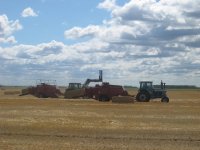I'm wanting to start baling and selling wheat straw. I would like to come in behind the combine after he threshes the wheat and lays it down in rows and then bale it into square bales. Just wondering what you all thought about this and if you think a farmer would even be interested in doing this? I've heard some good money can be made by doing this.
Another question.....Is there a big market for wheat straw? How hard would it be to sell and who would I sell it to? I could get close to 15,000 to 20,000 square bales.
Also, How big of an issue is baling behind a rotary combine? Does it chop the straw up too bad? Is there a way to take something off the rotor to help with this, such as the knives?
Another question.....Is there a big market for wheat straw? How hard would it be to sell and who would I sell it to? I could get close to 15,000 to 20,000 square bales.
Also, How big of an issue is baling behind a rotary combine? Does it chop the straw up too bad? Is there a way to take something off the rotor to help with this, such as the knives?

